Displaying items by tag: Centenary Plaque Unveilings
Centenary Ceremony to Mark Loss of Two Irish Sea Cargoship Steamers And Crews During WW1
#WWIcargoshipsCeremony - To mark the centenary of the sinking of two merchant cargo steamships in the Irish Sea and loss of life, an unveiling of plaques are to take place this Saturday in Dublin, writes Jehan Ashmore.
Family descendents of all 36 victims will be joined by community groups, the Lord Mayor of Dublin and the public to commemorate the separate incidents caused by German submarines.
The first cargoship to be struck by torpedo was S.S. Hare on 14 December, 1917, when on passage from Manchester to Dublin. The ship some seven miles east of the Kish Lighship, was attacked by submarine U-62 with the loss of 12 lives.
It was during the '1913 Lockout' that S.S. Hare became famously involved in delivering a cargo of relief food Liverpool to the starving strikers in Dublin. This historic event was also marked with a centenary commemoration by SIPTU and other Irish and UK trade unions with a re-enactment voyage as previously reported on Afloat.ie. This saw the charter of Ben Maye take on the role of 'S.S. Hare' having sailed the same route to deliver a symbolic cargo.
As for the other cargoship casualty, SS Adela was attacked by enemy action while on passage to Liverpool with a cargo of ivestock and coal. It was some 12 miles northwest of the Skerries off Anglesea, Wales that U-Boat 100 torpedoed the ship and taking with her 24 lives.
The majority of those on board who died were civilian seamen or cattle workers and it is understood that from both sinkings, only four bodies were recovered.
Most of the seafarers who died came from the close knit dockland communities, with the ships berthing along the inner city quays among them Sir John Rogersons Quay, part of what is now called the 'Docklands' quarter. It is here that the centenary commemoration will aptly take place at Sean O’Casey Bridge (Custom House Quay) at 1pm. The two plaques are to be unveiled there close to where both ships berthed before making 100 years their final voyages.
For relatives of both tradgedies, Dublin Port Company are to provide a vessel to sail into the bay to conduct a short ceremony and wreath laying service at sea.
Organising the events are the Adela-Hare Centenary Commemoration Committee which was established by the victim's relatives. Following Saturday's plaque unveilings, a reception is to be held along with a public exhibition and launch of a commemorative booklet.
Further events are planned up to December with the Committee given support from Dublin City Councils Commemorations Fund.
For more updated information on the commemoration visit the Committee's Facebook page here.





























































